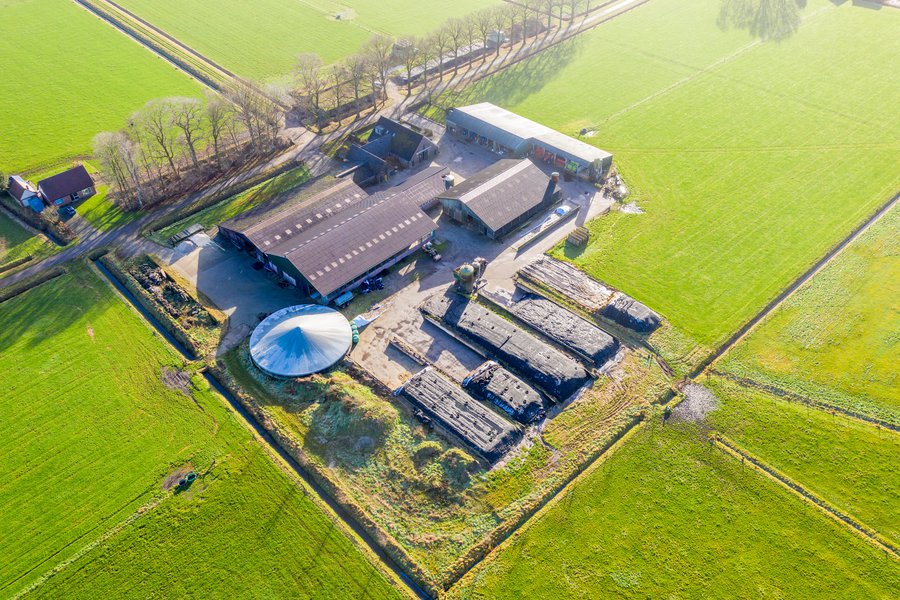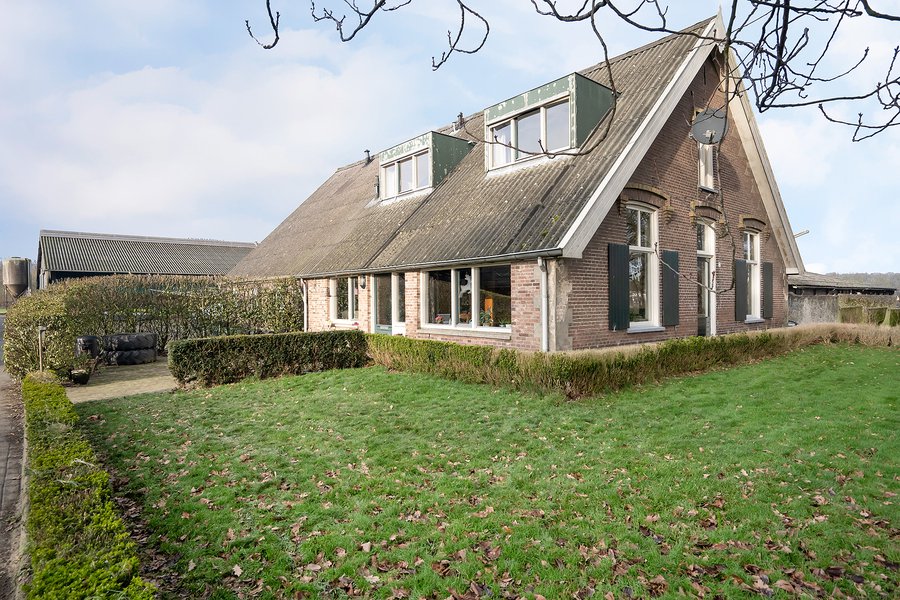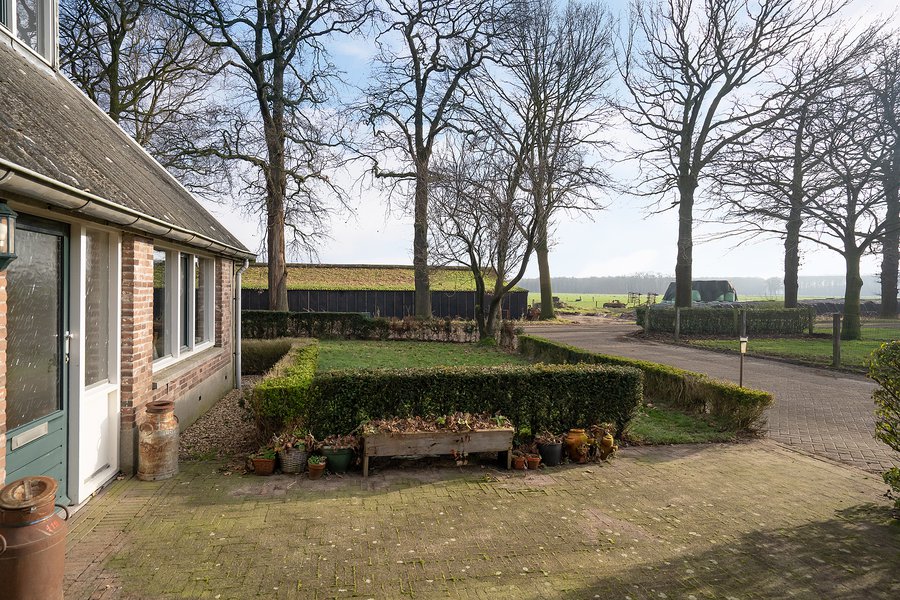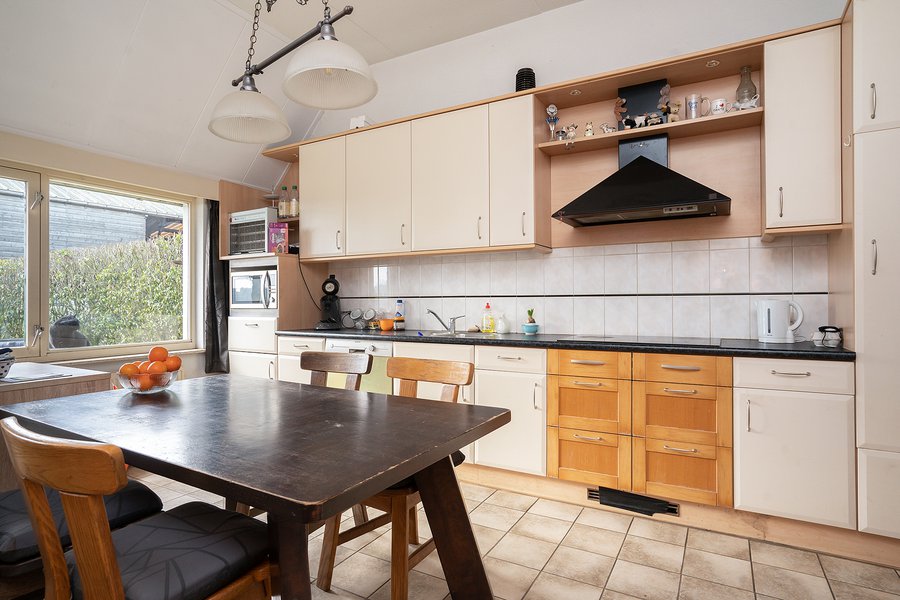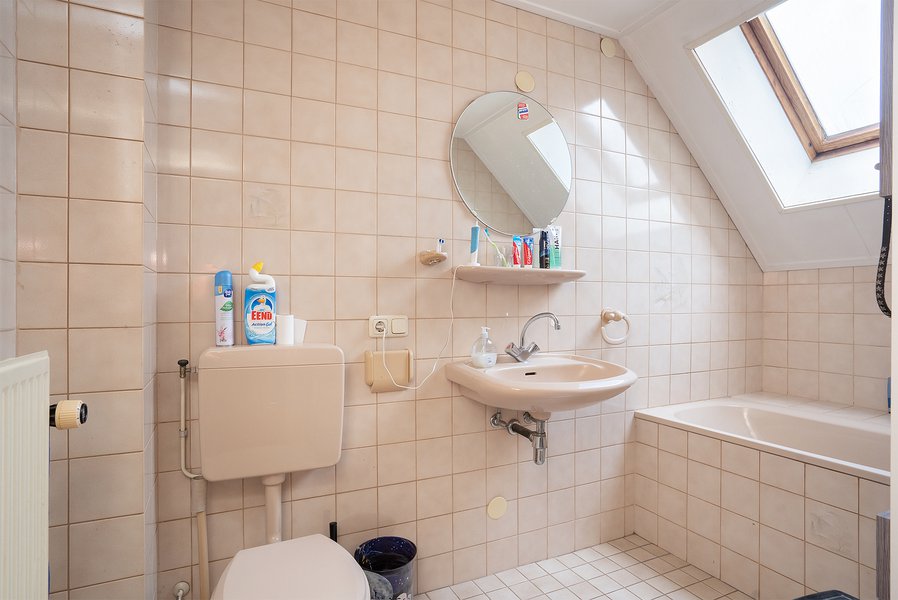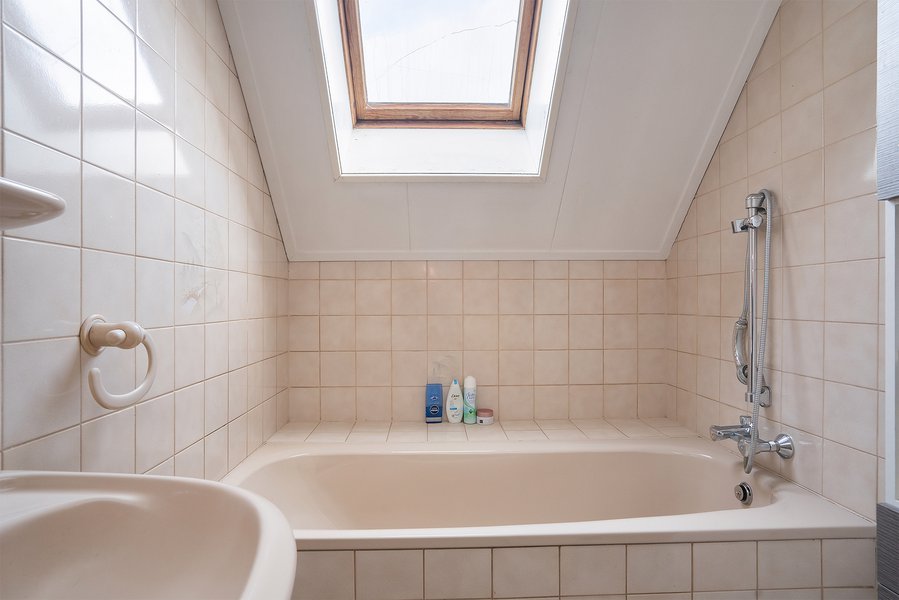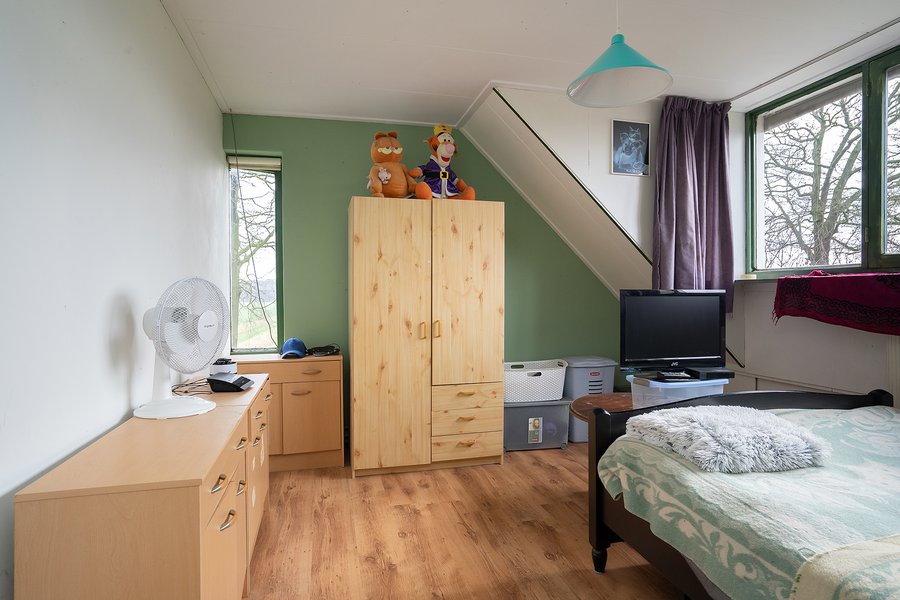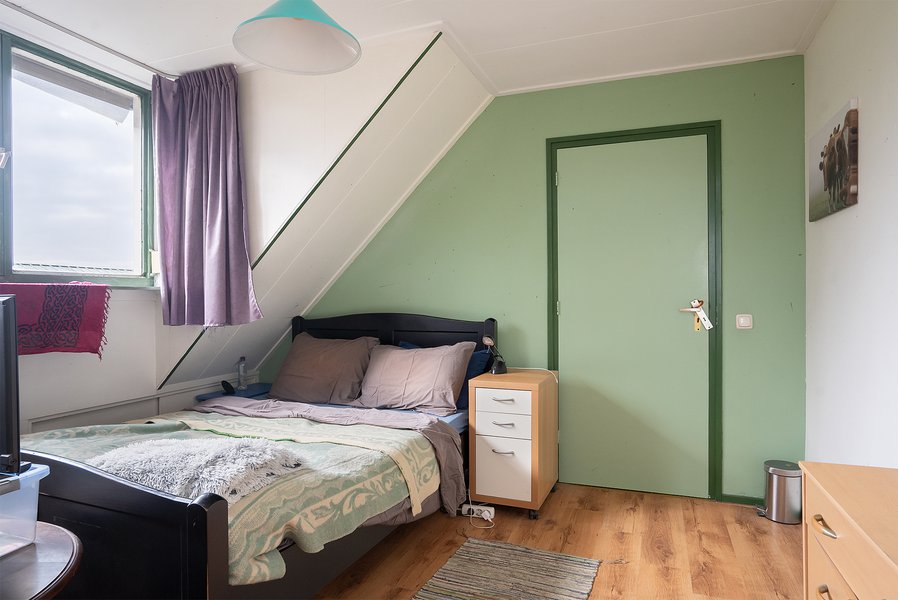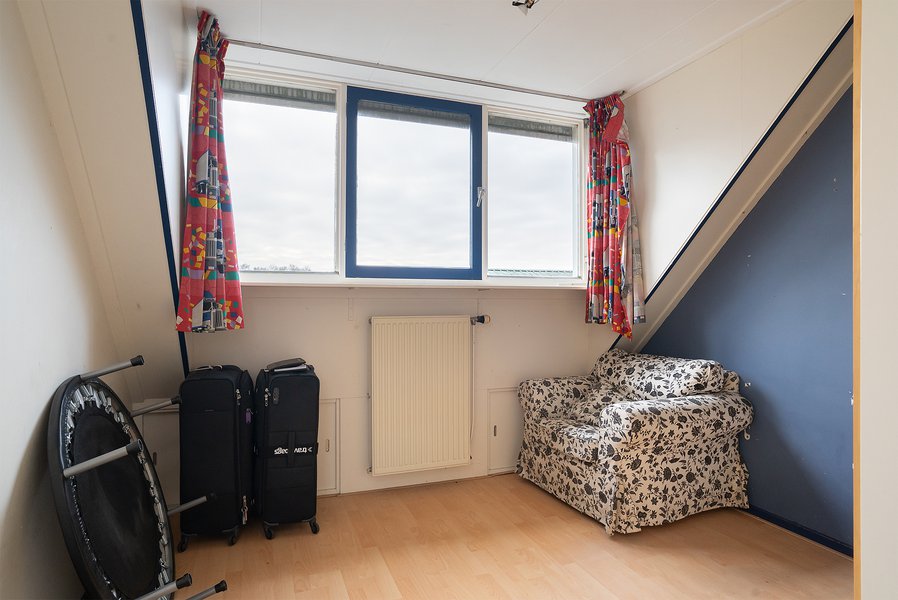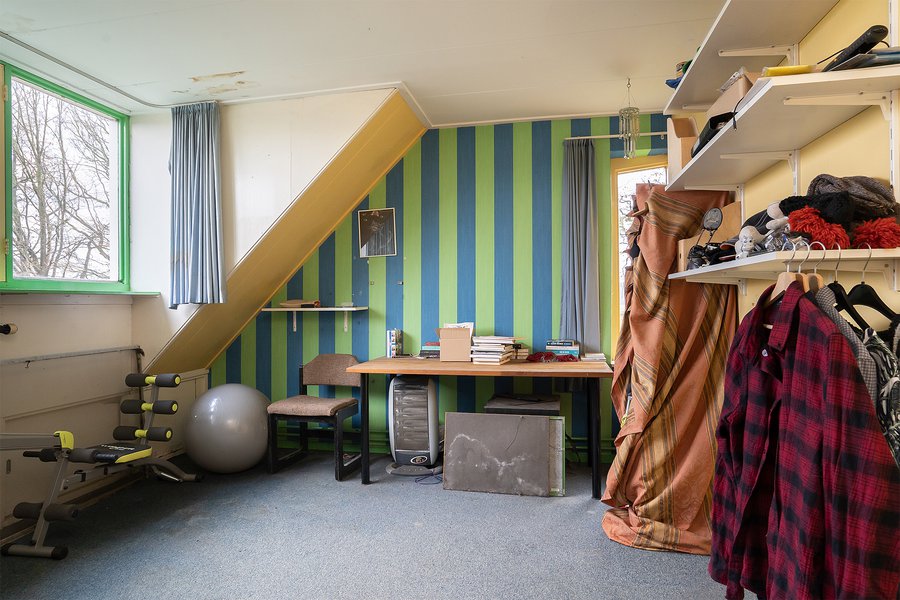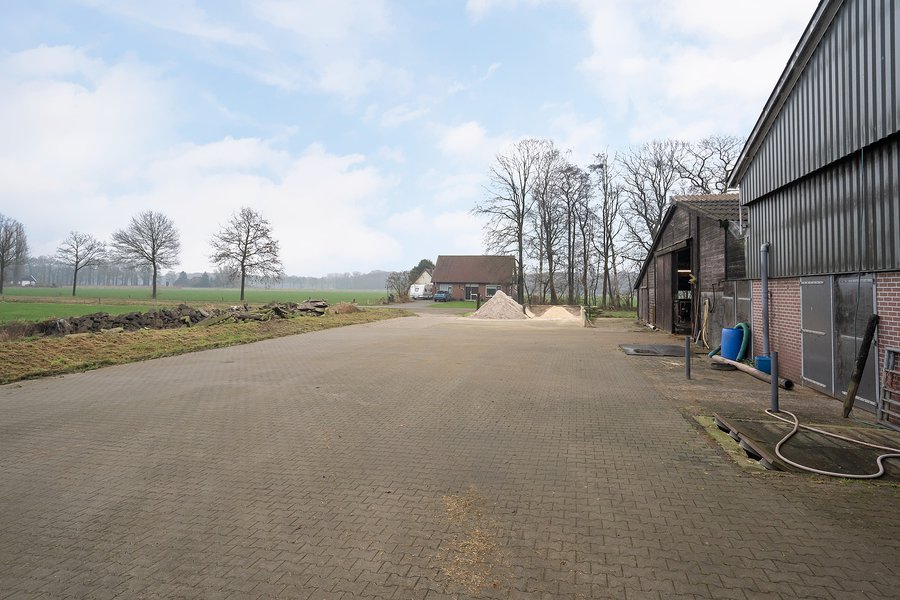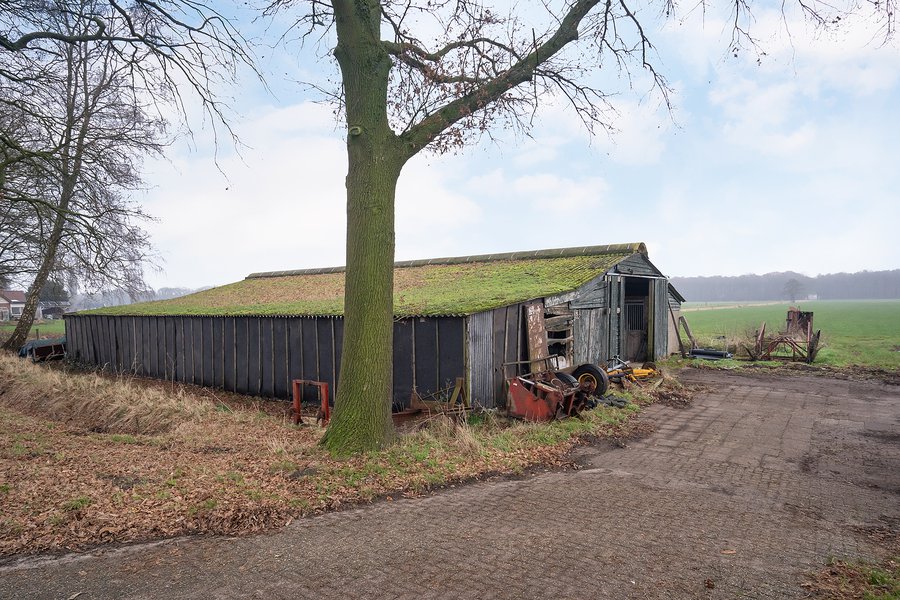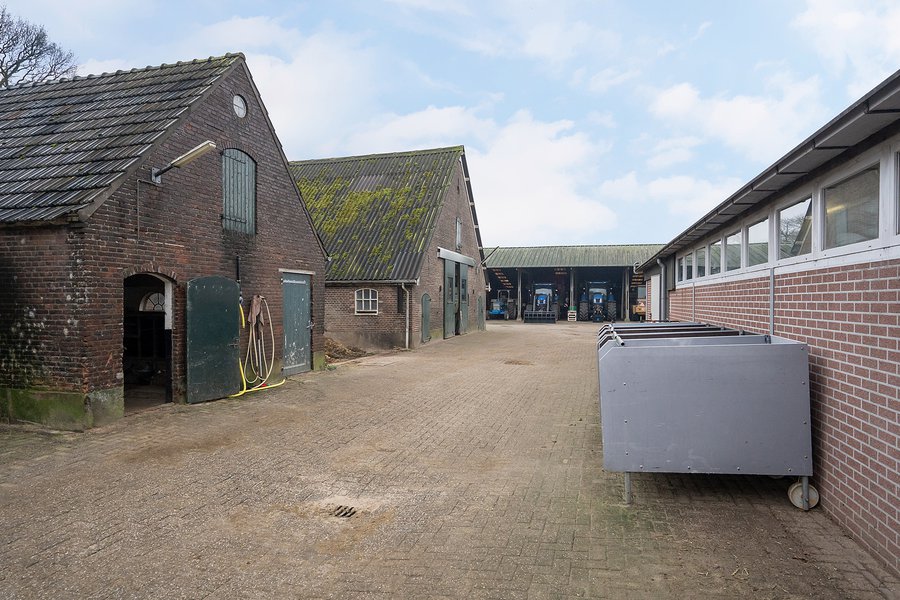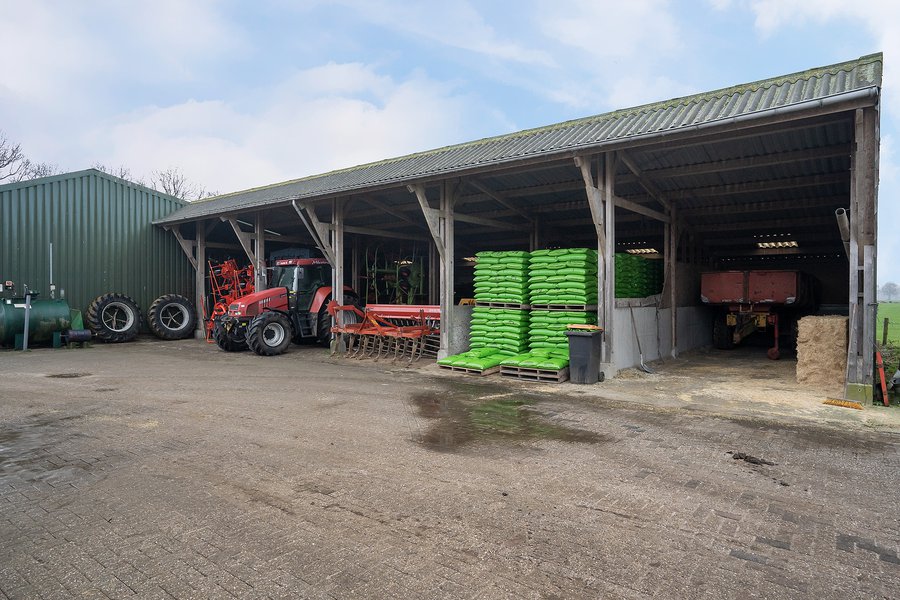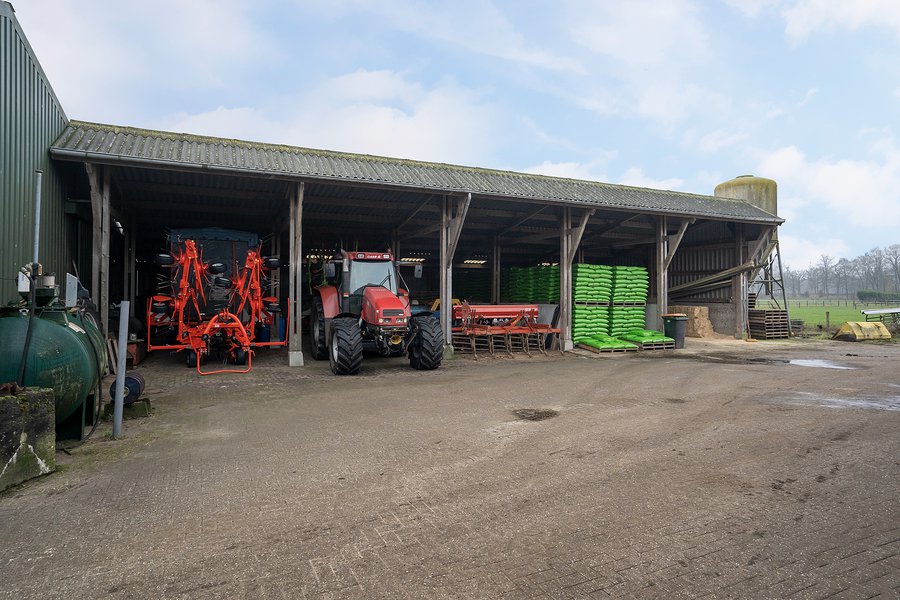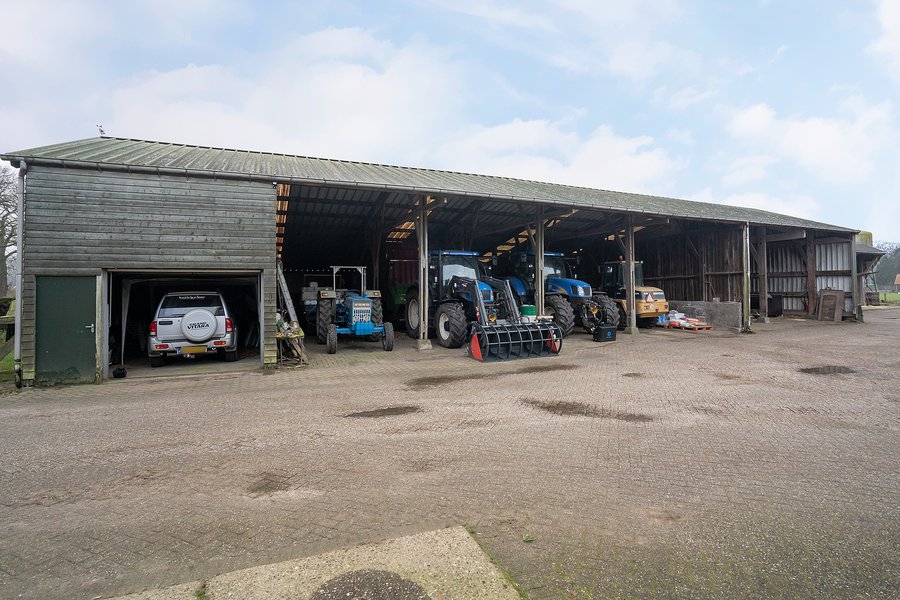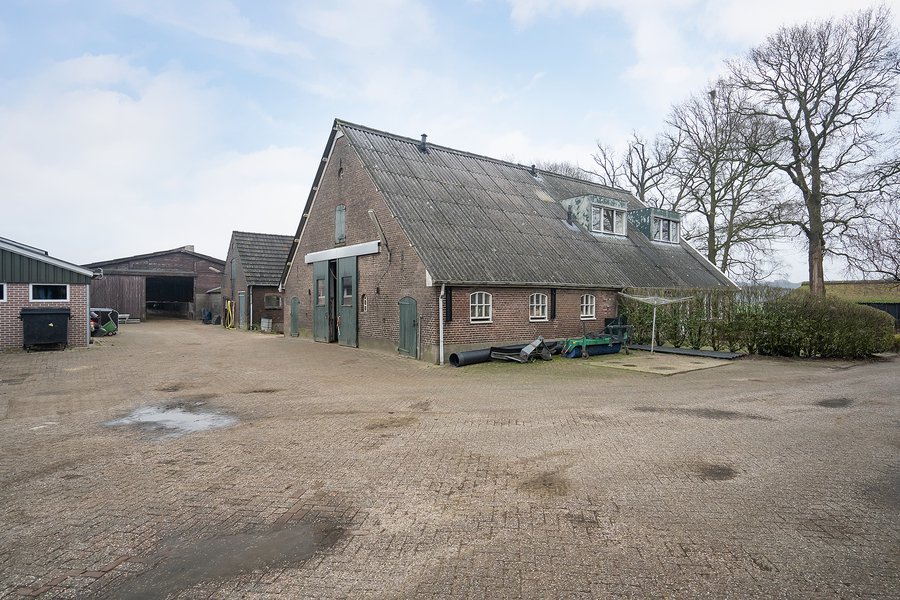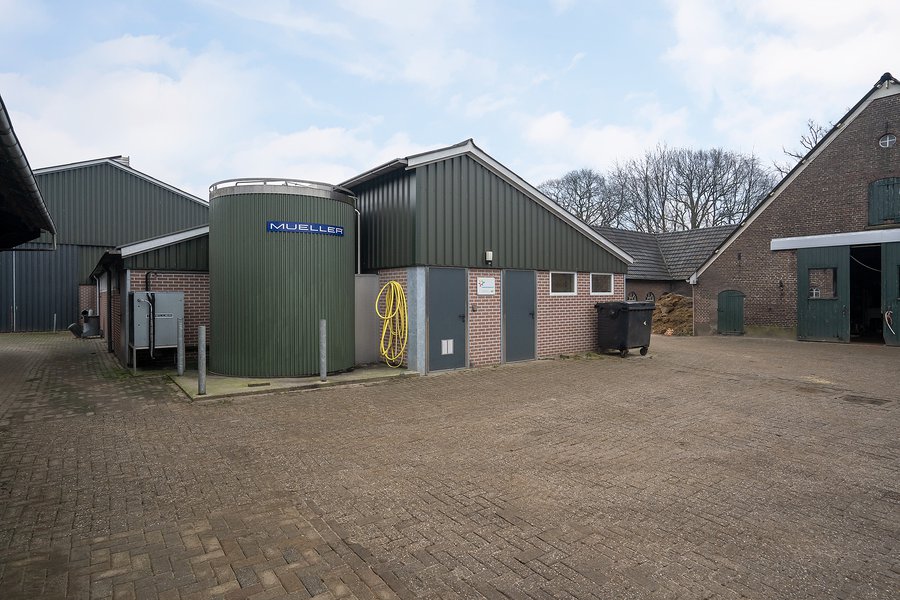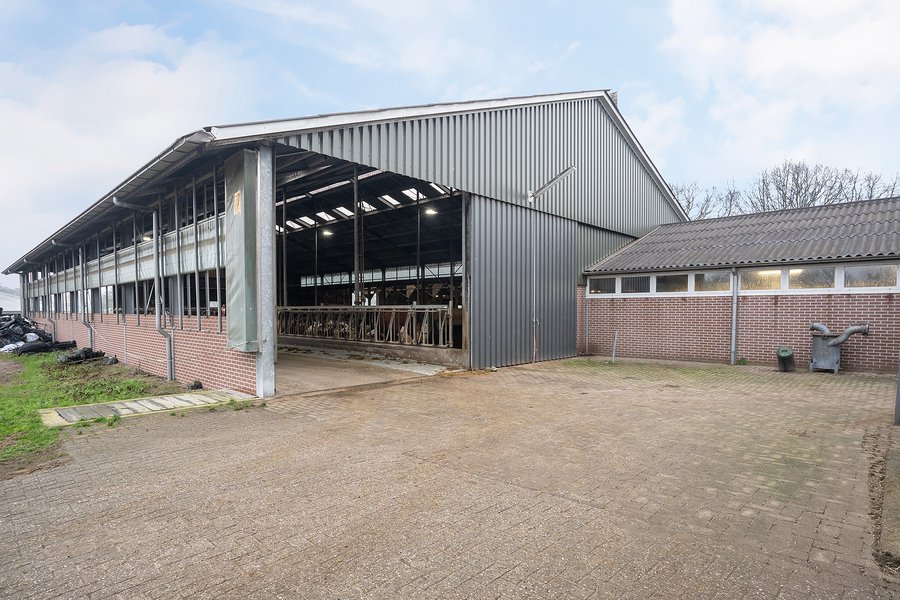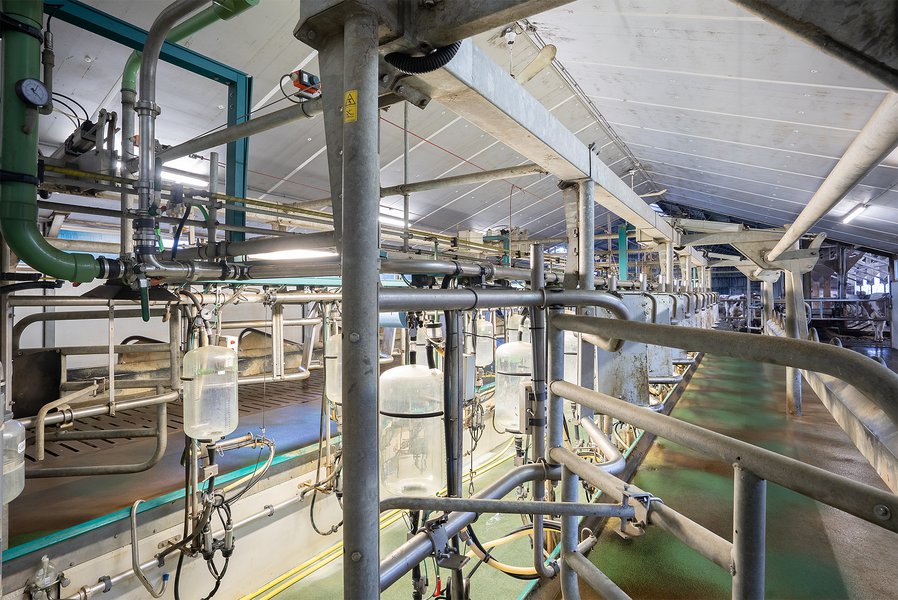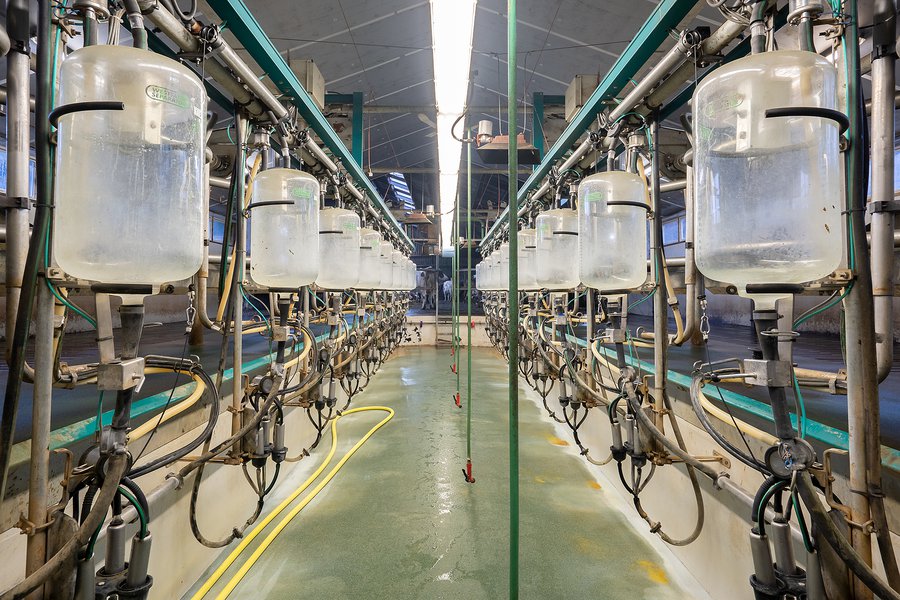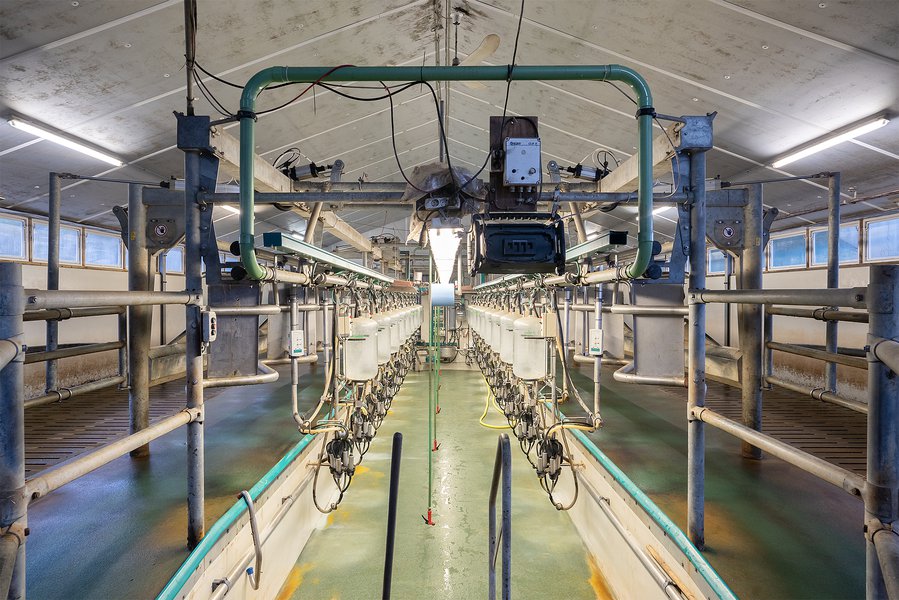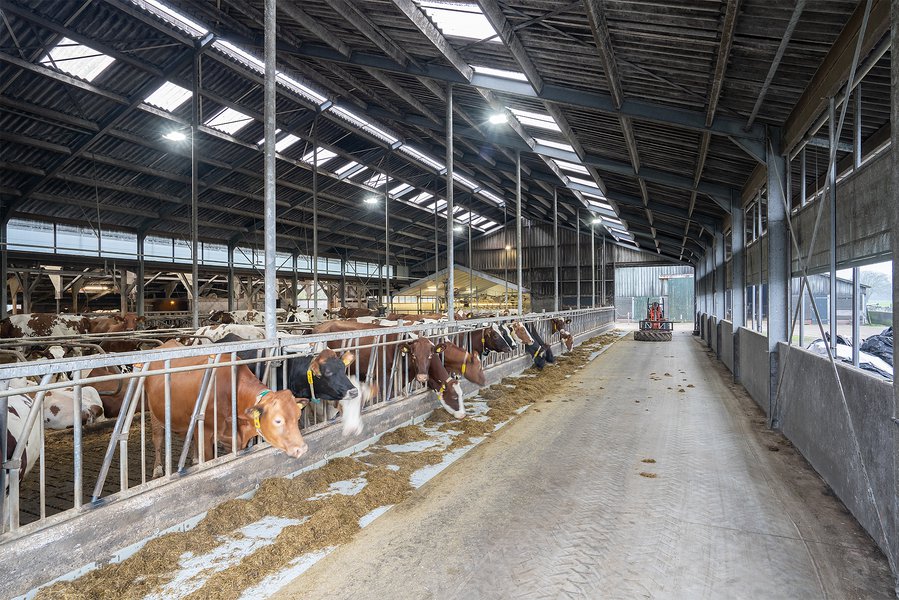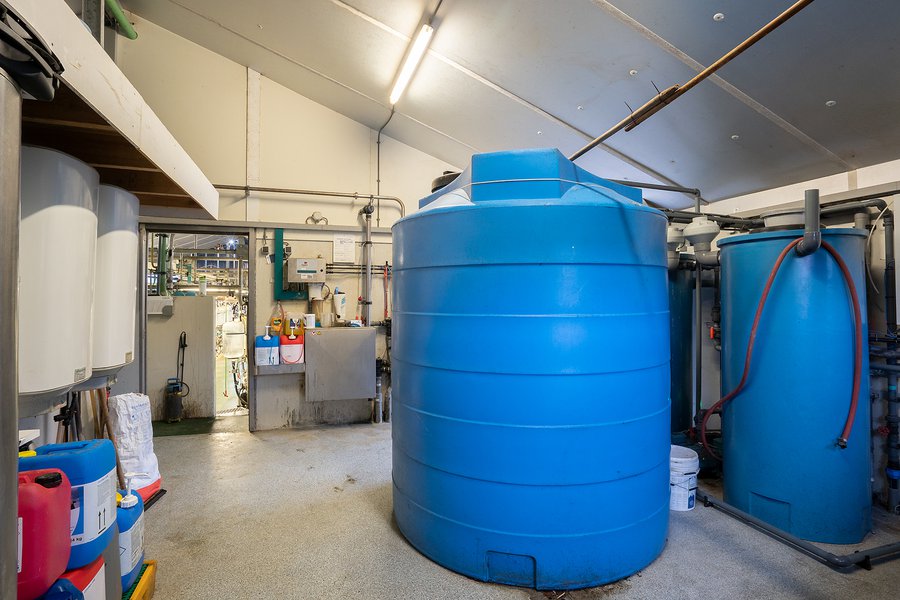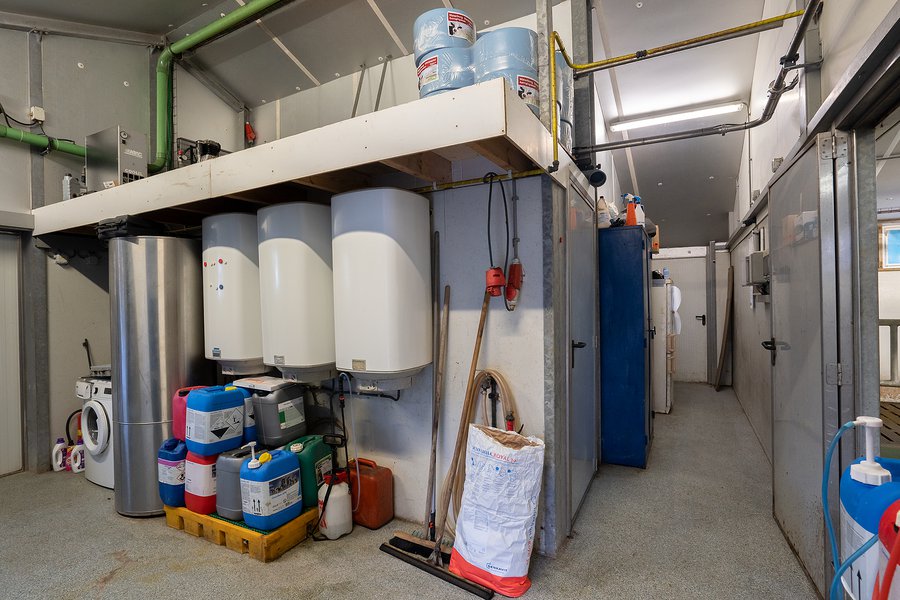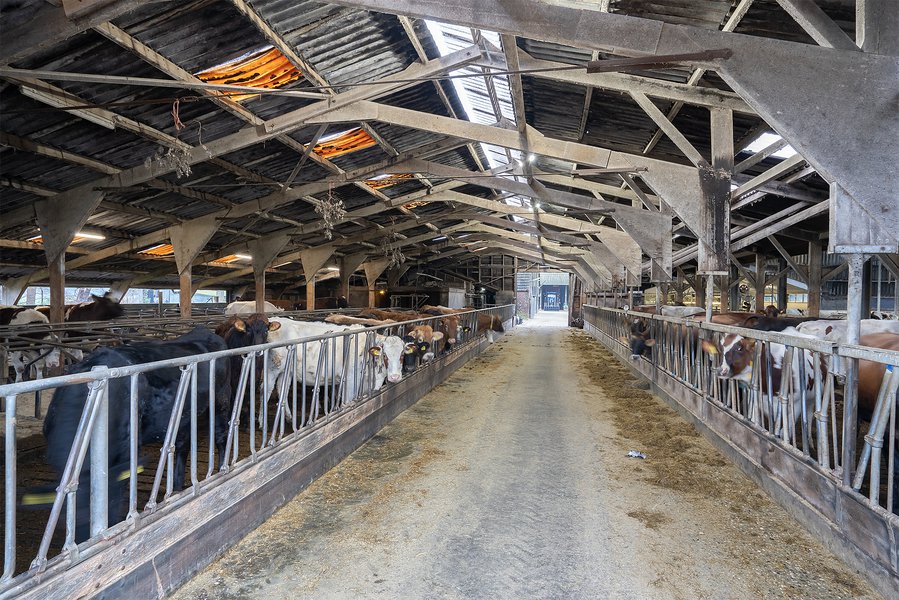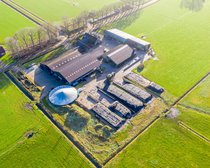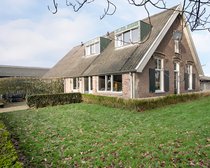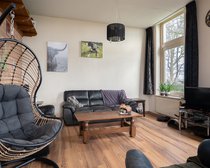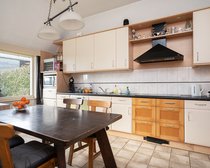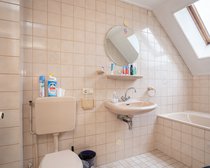Netherlands, 'T Zaaibroek 2 Hall
39.0 ha. price on request Sold Dairy
Hall, Gelderland, The Netherlands
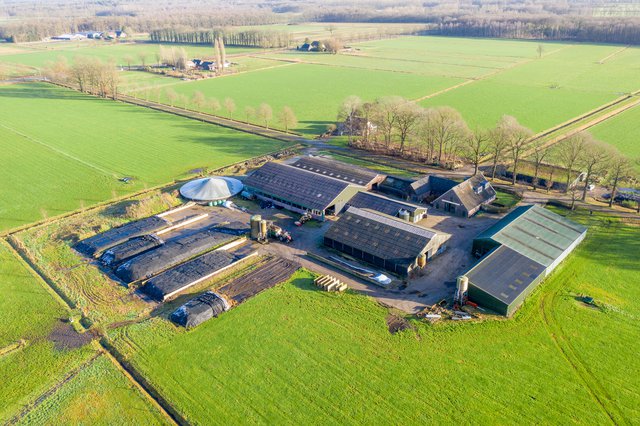
This modern dairy farm is for sale at the beautiful in Hall. Currently, there are about 100 cows are being milked on the farm. The company consists of a farmhouse, spacious free stall barn with 2x10 rapid-exit milking pit, young cattle barn, machine shed, trench silos, manure silo and approximately 38 hectares of cultivated land.
Location
The dairy farm is located about 3.5 km from the center of Eerbeek and about 5 km from the center of Brummen. These places offer facilities such as shops, primary schools, supermarkets, public transport and various sports facilities. The A50 and A1 motorways are easily accessible.
Residential building
Type: Farmhouse
Year of construction: 1887 (completely renovated in 1951 and then modernized several times)
Living area: approx. 143 m2
Volume: approx. 395 m3
Traditionally built farmhouse with an asbestos-containing corrugated iron roof.
- Ground floor: you enter the kitchen through the utility room. The kitchen is equipped with the necessary equipment such as an induction hob, dishwasher, microwave and refrigerator. Adjacent is the spacious living room with beautiful views of the landscape. Next to the living room is another room that can be used as a bedroom. In the hall, there is a toilet, storage cupboard and bathroom with shower and sink. You can walk through the hall to the office, which is also accessible through the stable.
- First floor: there are 3 spacious bedrooms, a storage cupboard and a bathroom with bath, toilet and sink.
- Loft: attic accessible via loft ladder.
Part
The rear of the farmhouse consists of an open space that is used as a workshop. There is also a spacious attic with storage options. Attached to the farmhouse is a barn with 3 straw pens. The office and a toilet can be reached through this barn. The barn is built of stone and has a tiled roof.
Free stall barn
Year of construction: 1972/ 2015
Layout: the barn consists of 2 parts:
- The new part was added in 2015 and has 100 deep litter boxes and 100 feeding places. It has a full basement and is equipped with LED lighting. You can go through this part to the outbuilding with the 2x10 herringbone rapid-exit milking parlor (WestfaliaSurge) with an automatic removal system. In addition to the newly installed spring water installation in 2021, there is a plate cooler, frequency controller and electric boiler. In the outbuilding, a special corridor has been set up for the milk tank driver, which includes the (rental) milk tank of approximately 15,000 liters.
- The original part is from 1972 and is built in stone with wooden trusses. It has an asbestos-containing corrugated iron roof. This barn has 51 cubicles with rubber mats and 50 feeding places; these spaces are currently empty but can certainly be used for any additional activities. It is connected to the previously usable milking pit, waiting room and technical room.
Young cattle barn
Year of construction: 1991
Surface: approx. 470 m2
The young cattle barn with wooden sidewalls on a masonry wall with steel trusses, a corrugated iron roof containing asbestos and a gable end. This barn has 67 cubicles and 3 straw pens. There is the possibility to realize a 4th straw shed. In addition, there is a calf feeder with 2 boxes (2007, WestfaliaSurge) and a new water system was installed in 2019.
Machine storage
Year of construction: 2008
Surface: approx. 750 m2
The machine shed consists of two parts, partly wood and partly sheet pile. In addition, there is a sheet pile roof and a partly asbestos-free corrugated iron roof. The front part is furnished as a machine shed and car garage. The rear part also provides space for machine storage and has 2 indoor trench silos.
Feed Storage:
There are 5 trench silos in the yard, all paved with H-clinkers. Silo 1 and 2 (maize and grass) are from 2015 and are 36 meters long, 9 meters wide and the walls are 1 meter high. Silo 3 (grass) from 2017 is also 36 meters long, 9 meters wide and the wall is 1 meter high. Silo 4 (grass) from 2018 is 36 meters long, 9 meters wide and has 1.20 meters high walls. Silo 5 is 6 meters wide and 25 meters long.
In addition to the trench silos, there are also a few other silos on the yard:
- Feed silo (6 tons)
- Young cattle feed silo (3 tons)
- Wet by-products silo (40 m3)
- Fertilizer silo (10 tons)
Manure storage
The yard has space for 2350 m3 of slurry, which is subdivided as follows:
- 1000 m3 manure silo (2019 new hood)
- 750 m3 free stall barn (new part)
- 400 m3 free stall barn (old part)
- 200 m3 young stock
In addition, there is a manure plate of approximately 40 m2 in the yard for the storage of solid manure.
Behind the cubicle shed is storage for sawdust and lime.
Cultivated land
The yard is located on approximately 1,300 m2. In addition, there are approximately 39 hectares of cultivated land. The current owner leases approximately 30 hectares of cultivated land, the lessor is not open to a new lessee. It is expected that these lands will come up for sale in the future.
Yard pavement
The yard is completely paved with partial vowels and H-clinkers.
Permits
NB permit and environmental permit available (to be requested from the broker).
Particularities
- 't Zaaibroek is a street for local traffic, which means little traffic.
- The company can be transferred in consultation as a “going concern”, whereby the current market value for livestock and stocks is determined on a date to be specified.
- Not included in the asking price are phosphate rights (5423 kg), livestock, machines (other than stable equipment), feed and movable property. In consultation, it is possible to take over certain matters.
Soil type
Veldpodzol soils; coarse sand
Municipality of Brummen, section Q numbers 53, 54, 58, 59, 75, 77, 84 and 419
Beekeerdgronden; loamy fine sand
Municipality of Brummen, section K numbers 107, 108 and 823.
Access
The yard is accessible via the paved road.
Infections
The seller is not aware of any contamination in the cultivated land.
Production rights
No production rights are included in the asking price.
Adjacent
Agricultural companies
Payment rights
Corresponding payment entitlements will be provided.
Destination
Agricultural with landscape values
Soil contamination
The seller is not aware of soil contamination.
Buyer costs
Transfer tax, notary fees, if applicable VAT and other costs are at the expense of the buyer.
Asking price
Price on request
Acceptance
In consultation
Viewing dates
Appointments for viewings can only be made with VSO brokers & appraisers. We request that you do not take the initiative to enter the site yourself. For further information and/or appointments for a viewing, please contact:
Contact
Nienke Hemeltjen
+31 (0)6 82 75 58 59
This offer is completely non-binding. The information in this brochure has been compiled as carefully as possible. However, if inaccuracies are found, no rights can be derived from this brochure.
-
id1795
-
priceprice on request
-
size39.0 ha.
-
typeDairy
-
countryThe Netherlands
-
countyGelderland
-
cityHall
- show on map

-
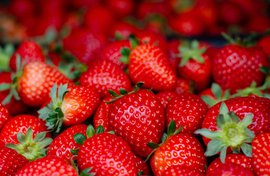 new
newAustralia, 275 Simpson Road Denbarker WA 6324
389.0 ha. Horticulture / Greenhouse...price on request (2535) -
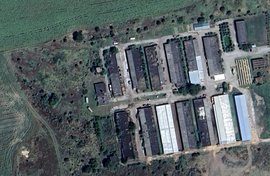 new
newBulgarije, Lom / Valchedram
320.0 ha. Cash crop...EUR 4,500,000,- (2532) -
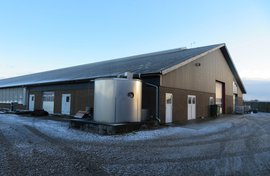 new
newDenmark, Farsø
55.6 ha. Dairy...price on request (2531) -
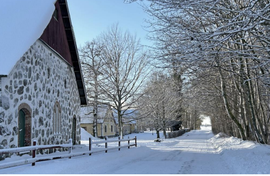 new
newSweden, Smedstorp
213.0 ha. Dairy...price on request (2530)
About The Netherlands
In the past centuries, not only nature has changed, but because of reduction and fragmentation of habitat, quality and quantity also deteriorated. Through nature management and activities of individuals the Dutch trying to turn the tide.
Agriculture is by far the largest user of the land area of the Netherlands. This makes agriculture vital to the rural area. In the period 1975-2003, the volume of total gross value added of Dutch agriculture has increased from 4.1 to 10.2 billion euros (2002 prices). In contrast, the share of agriculture in the Gross Domestic Product (GDP) over the same period decreased from 4.6 to 2.3 percent. The footprint of agriculture decreased the last thirty years by an average of 5 thousand hectares per year. Yet agriculture, with a current share of almost 60 percent in the total surface of the Netherlands, largely still defines the appearance of the Netherlands.
Expansion of agriculture means that entrepreneurs try to generate income from non-agricultural activities. These activities include agricultural nature and water management, agro-tourism and care farms. Currently, approximately 2 percent of the agricultural income derived from this type of activity.
The Netherlands has a temperate climate with mild winters and cool summers. The climate is influenced by the North Sea which moderates the temperature throughout the year, with both daily and annual temperature differences increasing towards the east.
De rol van de overheid ten aanzien van de verbreding in de landbouw is wisselend. De ontwikkeling van zorgboerderijen en agro-toerisme verloopt zonder veel overheidssturing. Bij agrarisch natuurbeheer is wel gekozen voor een sterke regie vanuit de overheid. Ongeveer de helft van de totale inkomsten uit verbreding van de landbouw is afkomstig uit agrarisch natuurbeheer.
Er zijn verschillende landbouwsubsidies voor boeren en agrarische bedrijven.
Bedrijfsovernamefonds voor startende boeren en tuinders
Er komt een extra financieringsmogelijkheid om startende boeren of tuinders te helpen de stap te maken naar een duurzaam en toekomstbestendig bedrijf. De Borgstellingsregeling Vermogensversterkend Krediet maakt het voor startende agrarische ondernemers makkelijker om op basis van een toekomstgericht ondernemersplan een lening aan te vragen.
Inkomenssteun via basisbetaling
Landbouwers die inkomenssteun via de basisbetaling willen ontvangen, kunnen jaarlijks de basisbetaling aanvragen via de gecombineerde opgave. Zij moeten wel voldoen aan bepaalde voorwaarden om voor inkomenssteun in aanmerking te komen. Zo moeten zij duurzaam en maatschappelijk verantwoord ondernemen.
Vergroeningsbetaling als aanvulling op basisbetaling
In aanvulling op de basisbetaling kunnen landbouwers in aanmerking komen voor een vergroeningsbetaling. In de volgende gevallen kunnen landbouwers in aanmerking komen voor een vergroeningsbetaling:
Als ze verschillende gewassen verbouwen (gewasdiversificatie). Dit is goed voor de biodiversiteit.
Als ze 5% van het bouwland inrichten als ecologisch aandachtsgebied. Het stuk bouwland levert een bijdrage aan de kwaliteit van biodiversiteit en milieu.
Als ze blijvend grasland in stand houden.
Extra betaling jonge landbouwers
Jonge landbouwers kunnen een extra premie ontvangen. Zijn de landbouwers in het jaar van de eerste aanvraag jonger dan 41 jaar? Dan kunnen zij hun aanvraag doen bij de Rijksdienst voor Ondernemend Nederland (RVO.nl). Met de premie kunnen jonge landbouwers investeren in grond, gebouwen, machines en verplaatsbare installaties.
Graasdierpremie
Laten landbouwers hun schapen of vrouwelijk vleesvee grazen op gronden die niet in aanmerking komen voor de basisbetaling? Dan kunnen zij een graasdierpremie aanvragen.
Borgstellingskrediet voor de landbouw (BL)
BL is voor landbouwbedrijven die de bank niet genoeg zekerheid kunnen bieden bij de afsluiting van een lening. De overheid staat met BL borg voor een deel van de bedrijfsfinanciering. Banken geven eerder een lening als de overheid voor een deel borg staat.
Vergoeding voor agrarisch natuurbeheer
Landbouwers die hun landbouwgrond natuurvriendelijk beheren, kunnen hiervoor een vergoeding aanvragen. Dit kan elk jaar van 15 november tot en met 31 december, via de regeling Agrarisch natuurbeheer (SNL).
Sommige boeren kunnen ook nog gebruikmaken van de regeling Kwaliteitsimpuls natuur en landschap (SKNL). Met deze regeling kunnen boeren hun landbouwgrond geschikt maken voor agrarisch natuurbeheer.
Tegemoetkoming premie brede weersverzekering
Agrarisch ondernemers met een brede weersverzekering kunnen een tegemoetkoming aanvragen voor de kosten van de verzekeringspremie. Dit kan via de tegemoetkoming premie brede weersverzekering.
Databank EU-subsidies landbouw
Wilt u precies weten wie er Europese landbouwsubsidie ontvingen? Dan kunt u dit nakijken in een databank met gegevens over landbouwsubsidies.
Het klimaat wordt beïnvloed door de Noordzee die het gehele jaar de temperatuur matigt, waarbij zowel de dagelijkse als jaarlijkse temperatuurschommelingen toenemen richting het oosten. In het noorden is de temperatuur gemiddeld over het gehele jaar iets lager dan in het zuiden. De kustprovincies in het zuidwesten, westen en noorden hebben in de herfst- en wintermaanden doorgaans zachter weer dan het oosten en noordoosten. In de zomer zijn het oosten van Brabant en uiterste noorden van Limburg de gemiddeld warmste plekken. De gemiddeld koudste maand is in de meeste plaatsen januari, de warmste maand juli.
Zonuren en neerslag
Met ca. 1650 zonuren heeft de kust de meeste zonuren, terwijl de Achterhoek met ca. 1500 uur de minste zonneschijn heeft. Ondanks het imago van regenland, regent het gemiddeld slechts 7% van de tijd. In de zomer is er vooral op grasland een verdampingsoverschot, maar gemiddeld is er jaarlijks een neerslagoverschot, het grootst op de Veluwe. Het natst zijn de Veluwe, Drenthe en Zuid-Limburg, het droogst het centrale deel van Limburg met minder dan 700 mm.
Weer
Het weer is sterk afhankelijk van de luchtsoort en de fronten die de verschillende luchtsoorten scheiden. Het meest voorkomend in Nederland is van de Atlantische Oceaan afkomstige maritiem polaire lucht die in de zomer vochtig en koud is en vochtig en gematigd warm in de winter. Bij een stormachtige noordwestenwind zorgt de maritieme Arctische lucht voor buiig, guur weer. Uit Rusland en Siberië wordt zomers warm en droge continentale polaire lucht aangevoerd. In de winter is deze koud en droog. Warme maritiem tropische lucht zorgt in de winter veel voor mist en in de zomer voor onweer. Continentaal tropische lucht is warm en droog.
De laatste vijfentwintig jaar is het aantal agrarische bedrijven in Nederland sterk gedaald. In 1980 waren er 144.994 landbouwbedrijven, daarvan waren er in 2019 nog 52.233 over. Ook het aantal mensen werkzaam in de landbouw is gedurende die jaren sterk afgenomen: van 265.467 in 1980 tot 196.000 in 2018.
Nederland is een op wereldschaal belangrijke exporteur van agrarische producten, ook al werkt maar 3% van de Nederlanders in de agrarische sector en is 2,2% van het bruto binnenlands product afkomstig uit de agrarische sector. De landbouw in Nederland heeft 2,2 miljoen hectare in gebruik. In 2015 was 54 procent van het totale landoppervlak van Nederland in gebruik voor landbouw.

